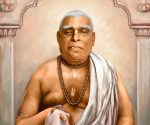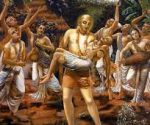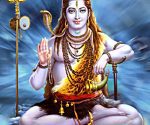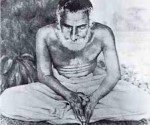Advaita Saptami – The Appearance Day of Sri Advaita Acarya
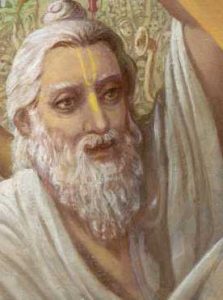 Srila Bhaktivedanta Narayana Gosvami Maharaja
Srila Bhaktivedanta Narayana Gosvami Maharaja
A Lecture taken from Srila Narayana Gosvami Maharaja’s
Sri Prabandhavali, [A Collection of Devotional Essays]
Advaita Saptami is the day that Sri Advaita Acarya appeared in this world. Sri Advaita Acarya, the cause of the material world, comes first; after that Sri Nityananda Prabhu comes on the day of trayodasi and then Sri Caitanya Mahaprabhu Himself, descending into this world with the effulgence of radha-bhava, comes on purnima. In this way the pastimes of Sri Caitanya Mahaprabhu begin.
vande tam srimad-advaitacaryam adbhuta-cestitam
yasya prasadad ajno api tat-svarupam nirupayet
(Sri Caitanya-caritamrta Adi-lila 6.1)
“I pray to Sri Advaita Acarya, who performs especially wonderful pastimes, that by His mercy I may be able to easily describe this difficult-to-understand philosophical truth.”
What are his wonderful pastimes? Some of them are as follows:
Seeing Sri Nityananda Prabhu, Advaita Prabhu began complaining. “Where has this avadhuta*[see endnote 1] come from? Today He has come to our home and thrown prasada in all directions! He has no knowledge of what caste He belongs to; actually He has no caste at all. We are brahmanas, the best of society, and He has dropped prasada on the bodies of everyone here.”
Then Nityananda Prabhu said, “O offender! You are committing an offence to maha-prasada. You consider it to be mere food, and that it is merely being thrown around? You can’t see that it bestows good fortune, and that whoever’s body is touched by it at once crosses over maya.”
In this way, there was generally some transcendental loving quarrelling between Them. When they would go for bathing there would certainly be quarrelling. At that time Nityananda Prabhu was very young. Sri Caitanya Mahaprabhu was the youngest, next came Lord Nityananda, and the oldest was Sri Advaita Acarya, whose thoughts are sometimes very difficult to understand.
He sent a mysterious sonnet to Sri Caitanya Mahaprabhu.
baulake kahiha, – loka ha-ila baula
baulake kahiha – hate na vikaya caula
baulake kahiha – kaye nahika aula
baulake kahiha – iha kahiyache baula
“One madman is sending a message to another madman. There is no longer necessity for rice in the marketplace, so it is time for the shop to be closed.” (Caitanya-caritamrta Antya-lila 19.20,21)
Practically no one could understand this sonnet. Upon reading it, Sri Caitanya Mahaprabhu appeared a little indifferent. Only Sri Svarupa Damodara could understand a little of Sri Advaita Acarya’s mood; no one else could understand.
He said that one madman, Sri Advaita Acarya who is maddened in krsna-prema, is sending a message to another madman, Sri Caitanya Mahaprabhu, the one who made the world mad with krsna-prema, the original madness. “There is no longer necessity for rice” means that prema has been given by Him to everyone, and now the task is completed. “Therefore the shop should be closed” means, “Your pastimes in the material world should now come to a close.” No one understood this; only Sri Svarupa Damodara could know something of its meaning. In this way, Sri Advaita Acarya’s pastimes are mysterious and wonderful.
Although the gist of the Bhagavad-gita advocates bhakti, at the time of Sri Advaita Prabhu’s appearance no one was explaining it in that way. The message of the Gita is full of devotion – visate tad anantaram (Bhagavad-gita 18.55): “Ultimately he enters into Me.” Advaitavadis interpret this to mean that God and the jiva merge and become one. They say that by chanting, “aham brahmasmi” and practicing meditation, the apparent individuality of the souls merge in the end, and that the material world is false. Sri Advaita Acarya first of all gave the explanation of bhakti from these verses: satatam kirtayanto mam (Bhagavad-gita 9.14); ananyas cintayanto mam, ye janah paryupasate (9.22); and labhate bhakti param (18.54) – in the end, we will attain bhakti. By the medium of the precepts described in these verses, we enter into bhakti. It is not that we meet God in Brahman, the undifferentiated light. Visate means that we enter into His residence or abode and attain His service, but some people were trying to change the meaning.
After some time, Sri Advaita Acarya went to Santipura and also started explaining the meaning of visate tad anantaram as “aham brahmasmi: all souls will merge in Brahman.” Hearing of this, Sri Caitanya Mahaprabhu went to him and pulled His beard and beat Him, until Srimati Sita devi, Advaita Acarya’s wife, came and protected Him. This is also wonderful, because having been beaten, Sri Advaita Acarya became very pleased and began dancing. Previously, Sri Caitanya Mahaprabhu had been offering respects and services to Him, befitting one’s guru. This was because Sri Advaita Prabhu was a disciple of Madhavendra Puri, Sriman Mahaprabhu’s grand-spiritual master. Mahaprabhu was thinking, “He is a disciple of My parama-guru (grand-spiritual master), so it is My duty to offer obeisances and service to Him. He is worshipable for Me, and therefore I should serve Him.”
For ridding Himself of this situation, Sri Advaita Acarya gave the nirvisesa-vada (impersonal) explanation of the Gita. When Sri Caitanya Mahaprabhu became angry and started beating Him, Advaita Acarya said, “Today My life has become successful. I wanted You to accept service from Me, because You are senior to Me. Who can possibly be senior to You?” Mahaprabhu then became shy.
Another time, Sri Caitanya Mahaprabhu said to His mother, Srimati Saci-devi, “I will not show love to you anymore, because you have disrespected a devotee. You have committed vaisnava-aparadha. You told Sri Advaita Prabhu, “Your name Advaita (meaning non-dual) is not suitable; rather Your name should be called Dvaita (dual). You are not advaita, You are dvaita.” You said that Sri Advaita Acarya brings “duality”, separation in relationships. He separates a mother from her son, a father from his son, a brother from his brother. Advaita Acarya explains the path of devotion, thereby breaking the chains which bind one to the material world. A mother has natural affection for her offspring, but if Advaita Prabhu is able to increase someone’s spontaneous attraction towards Lord Krsna, what could be greater than that? If someone is giving the instruction that the jiva has forgotten God for millions of births, and then establishes knowledge of our true relationship with Him and the final attainment of love for Him, and gives instruction for bhajana which cuts the chains that bind us to the material world, what could be greater?”
Srimati Saci-devi replied, “He separated me from my beloved Visvarupa. He gave such instruction to him that it separated me from my son, who left home and became a sannyasi. Advaita Acarya is that person whom having met once, one will not desire anything within this world. So His name should be “Dvaita”.
Sri Caitanya Mahaprabhu said, “Since you spoke to a devotee in this way, none of us will show you love anymore.” As she stood there, everyone present told her the same thing. Saci-devi then went to beg forgiveness from Advaita Acarya, but before she could do so he fell at her feet and said, “You are the mother of the entire world. It is not possible for you to commit any offence. But alright, if someone says that there has been some offence, then I say it is hereby forgiven.” Saci-devi returned to Mahaprabhu and everything was set right. Many wonderful pastimes like this were performed by Sri Advaita Prabhu.
Sri Advaita Acarya was instrumental in bringing Sri Caitanya Mahaprabhu to this world. At the end of Dvarapa-yuga, upon completing His pastimes in this world and returning to Goloka-Vrndavana, Sri Krsna thought, “I have three desires which have not yet been fulfilled. Understanding the glories of Radhika’s love, discovering the sweetness that She finds within Me, and tasting that sweetness – without assuming the sentiment of Radhika Herself and the effulgence of Her form, it will not be possible to experience these three things. I have tasted sakhya-rasa (the mood of friendship), vatsalya-rasa (the parental mood), and madhurya-rasa (the mood of a paramour), but as yet I have been unable to experience what Her happiness is upon seeing Me, and what is the nature of Her love for Me.”
At that time, it was necessary for the yuga-dharma (the religious principles for this Age) to be given. The Age of Kali, which lasts for 432,000 years, had come. Ordinarily, at the end of each yuga an incarnation of the Supreme Lord comes, just as at the end of Treta-yuga, Sri Ramacandra came, and at the end of Dvarapa-yuga, Sri Krsna came. Such a yuga-avatara comes when the disorder in the material world has reached its highest limit.
dharma-samsthapanarthaya
sambhavami yuge yuge
“In order to re-establish the principles of religion, I appear millennium after millennium” (Bhagavad-gita 4.8)
The Supreme Personality of Godhead thinks, “Just see how much sinful activity is increasing, and how the chaos is escalating due to the demons. I should descend.”
There are actually four reasons for Sri Caitanya Mahaprabhu’s descent. Two are primary and two are secondary. The most primary reason is for tasting the prema of Radhika, and the second reason is:
anarpita-carim cirat karunayavatirnah kalau
samarpayitum unnatojjvala-rasam sva-bhakti-sriyam
“By His causeless mercy He appears in the age of Kali to bestow what no incarnation has ever offered before: unnata ujjvala-rasa – the most sublime conjugal mellow of His own service.” (Caitanya-caritamrta Adi-lila 1.4)
Sri Caitanya Mahaprabhu wanted to give the wealth of a special love to the jivas, which had never been bestowed by any previous incarnations: unnata ujjvala-rasa – the parakiya-bhava of the gopis. There are two kinds of unnata ujjvala parakiya-rasa. One kind, the sentiment of Radhika, is not ‘giveable’. But the other, the sentiment of the nitya-sakhis and the prana-sakhas who serve Radha, and who, following Her, also serve Krsna – that unnata ujjvala-rasa can be given. Therefore, to bestow the highest prema upon all jivas and to taste the prema of Radhika, Krsna decends as Mahaprabhu.
His third reason for the His coming is to preach the yuga-dharma, nama-sankirtana; and the fourth reason is:
yada yada hi dharmasya
glanir bhavati bharata
abhyutthanam adharmasya
tadatmanam srjamy aham
“Whenever and wherever there is a decline in religious practice, O descendent of Bharata, and a predominant rise of irreligion – at that time I descend.” (Bhagavad-gita 4.7)
These are the four reasons.
Krsna was thinking, “When should I go? To establish the yuga-dharma, it is alright to descend at the end of the yuga, but if instead I preach nama-sankirtana at the beginning of the yuga, the degrading influence of the yuga will have a lesser effect on the jivas. When should I give the sentiment of the gopis, and when should I taste the love of Radhika?” He was considering all of these things.
Meanwhile Sri Advaita Acarya saw that bhakti was gradually disappearing from the world, and He thought, “Now is the appropriate time for Sri Krsna’s incarnation. If He doesn’t come now, what will happen later?” He was thinking this in the form of Karanodasayi Visnu. He was pondering in that place where sattva, rajas, and tamasa (the material qualities of goodness, passion and ignorance) are all in the same position.
There are two causes of the world: one is upadana, the ingredient cause, and the other is nimitta, the efficient or instrumental cause. Lord Maha-Visnu Himself is the nimitta cause, and His part, Sri Advaita Acarya, is the upadana cause. Suppose I were to point to someone and say, “This man is a hooligan, a thief and a liar. Grab him and throw him outside; he should never be allowed in here again.” You may not know him, but by my saying this you throw him out. So, who is the cause of his being thrown out? By my order you grabbed this man and ejected him, so you are the upadana cause and I am the nimitta cause. But who is the real cause of the man being ejected? By his own misbehavior, the man himself is the cause; and this is exactly the situation regarding the creation of the material world.
Karanodasayi Visnu assumes two forms to create the material world: as the efficient or instrumental cause and the ingredient cause. When the two of them come together, countless universes are generated. But if the Lord did not inject His desire, nothing would have transpired. In any activity, there is first the desire for it to take place.
Therefore the desire of Maha-Visnu is the primary cause, and dependent on His desire is the desire of Sri Advaita Acarya, which is the secondary cause. In this way Karanodasayi, Visnu performs the activity of creating the world, and His incarnation is Sri Advaita Acarya.
advaita-acarya gosani saksat isvara
yanhara mahima nahe jivera gocara
“Sri Advaita Acarya is directly the isvara Himself. His glories cannot be comprehended by ordinary living beings.” (Caitanya-caritamrta Adi-lila 6.6)
From mahat-tattva, false ego arises. From false ego comes form, smell, touch, taste, and sound. Next come the eleven senses, and next are the five material elements. That makes twenty-two material elements, and with the intelligence and mind there are twenty-four. Then, adding prakrti, purusa, atma, and Paramatma, there are twenty-eight aspects of tattva altogether. Leaving aside the Supreme Lord and the living entity, only the remainder is accepted by the sankhya and nyaya schools of thought.
ye purusa srsti-sthiti karena mayaya
ananta brahmanda srsti karena lilaya
icchaya ananta murti karena prakasa
eka eka murte karena brahmande pravesa
se purusera amsa – advaita, nahi kichu bheda
sarlura-visesa tanra – nahika viccheda
sahaya karena tanra la-iya ‘pradhana’
koti brahmanda karena icchaya nirmana
“Maha-Visnu performs the function of creation of all the material universes, and Advaita Acarya is directly an incarnation of Him. Creating and maintaining these countless universes by His external energy is His pastime, and by His own will He expands into countless forms and enters into each and every universe. Advaita Acarya is a non-different part and parcel of Maha-Visnu, or in other words, another form of Him.” (Caitanya-caritamrta Adi-lila 6.8-11)
Some say that nature enacts the process of creation by itself, and they give this example: “A cow eats grass, and automatically milk is produced. What is the necessity of anyone else in this process? In this way nature does everything by itself.” To refute this, an innocent, less-educated Vaisnava once said, “The cow eats grass and then gives milk, so why then doesn’t the bull eat grass and also give milk? Does he need to eat more grass?” The scholar of the sankhya school had to think for a moment. Then he said, concerning the upadana or ingredient cause, “To make a house, all elements such as bricks are necessary.” Then the Vaisnava said, “So, if by bricks or cement a house will be made, then here we will place one thousand kilos of cement, ten-thousand bricks, an entire lake of water, and wood and marble also. Will that make a house? By the upadana alone it will not happen, because it needs the nimitta or instrumental cause. There may be a pen and paper, but will they write by themselves? Thus, by the material nature alone creation will not take place. There must also be the desire of the Supreme Lord.”
No action can take place by itself in the material world, and therefore this prakrti-vada philosophy is erroneous. Prakrti is inert matter, and Purusa is conscious; when both come together there is creation. In prakrti there is no action, no innate desire – it is inert matter. However, when it is activated by the Purusa, the task is automatically accomplished. The communists say, “What is the need of God in this? Nature does creation by itself”. But there is no one in the world who can create by himself.
A lame man and a blind man were going somewhere together, and the lame man said, “Take me on your shoulders. Seeing with my eyes, I will tell you to go right, left, or straight on the path, and we will go there with your legs. Otherwise, you will not be able to go there, and neither will I.” Working together, they reached their desired destination. In this example the lame man is conscious, and the blind man is also conscious, and both being conscious, the work was done. In creation, on the other hand, only God is conscious; nature is not. Without at least one conscious being, no work in the world can be done.
These issues may seem dry, but they are actually very important and tasteful points related to bhakti, and Vaisnavas should make an effort to understand them.
In all this tattva, elaboration of established truths, the root cause of the material world is Lord Krsna – because originally He injects His desire. He then becomes two kinds of Sankarsana: first the root or Mula-Sankarsana, and then Maha-Sankarsana. From Maha-Sankarsana He becomes Karanodasayi Visnu, and subsequently He becomes Sri Advaita Acarya as the upadana cause. Some people say that the upadana cause is separate from the Lord, that it is not God. They say that God may be the nimitta cause, but He cannot be the upadana cause. However, besides Sri Krsna there is nothing, so from where has the material world come? From where has the mahat-tattva (the sum-total material ingredients) come? It has also come from the desire of Krsna. There is nothing in all of existence that is separate from Him. Karanodasayi manifests the creation, and the mahat-tattva, nature herself, is thus non-different from Him. To correct the souls that have forgotten God, material nature is manifest by His desire and it gives the jiva an external form. The jiva may consider his placement in that condition of life to be an opportunity for great happiness, but actually it is a punishment. When a crazy man dances around naked, people beat him. Without eating or drinking he wanders about, saying, “I am the King” or “I am the Prime Minister” – and he thinks himself to be happy. Our condition is exactly like that. We may consider ourselves happy, but in reality we are not in a happy condition at all.
Thus Sri Advaita Acarya was thinking, “The world has become atheistic. One after another, people are forgetting God, and for Me to rectify them alone is not possible. To bring devotion to the non-devotees will be very, very difficult work. Without the potency of Lord Krsna Himself, it simply cannot be done.”
Besides devotees, there are many people in the world who are preaching, but they are all preaching maya. They preach twisted philosophies, and seeing this Sri Advaita Acarya thought, “They have no relation with God and they do not preach bhakti. Even when they do preach from the Srimad-Bhagavatam and the Gita, they express only the desires of their minds. They are indifferent to sanatana-dharma and pure devotion, and all of them –especially the mayavadis – will only hear what they want to hear.
“Defeating Ravana was not a very difficult task, and killing Kamsa was also not difficult. These actions could have been done by a Visnu incarnation, but changing the thinking of these mayavadis is very difficult. It will only be possible if Krsna Himself comes into this world.”
Since Sri Advaita Prabhu was at least sixty years old when Sri Caitanya Mahaprabhu appeared, He was the oldest of all of His associates. Sri Nityananda Prabhu was approximately five years older than Sri Caitanya Mahaprabhu.
Sri Caitanya Mahaprabhu’s plan was that He would first arrange for His devotees to appear in the world, and then He would personally descend. Sri Advaita Acarya appeared first, and seeing the condition of the world, He thought, “How will I call Krsna? There are so many types of worship of Krsna, but amongst all of these, the glories of tulasi worship are the greatest. Sri Krsna will be so pleased with anyone who offers Him a tulasi leaf and Ganges water that He will become overpowered.” Thus, He took a tulasi bud – two soft leaves with a manjari in the middle – and with great prema and tears flowing from His eyes, he worshipped Krsna beside the Ganges.
Krsna had originally been thinking, “When will I descend? Maybe in ten or twenty thousand years, or maybe even after one hundred thousand years.” But upon hearing Advaita Acarya’s prayer, He came at once. Therefore, Sri Advaita Acarya is another important reason for the descent of Sri Caitanya Mahaprabhu.
At birth, Sri Advaita Acarya was given the name Kamalaksa, because His eyes were as beautiful as lotus petals. He appeared at Sri Hatya in East Bengal. Staying sometimes in Navadvipa and sometimes in Santipura, He began preaching bhakti. He was there in Navadvipa when Sriman Mahaprabhu took birth. Sri Visvarupa, Lord Caitanya’s older brother, attended Advaita Prabhu’s school. One day Mother Saci told Nimai to go and call His brother. When He arrived at the school, Nimai glanced in the direction of Sri Advaita Acarya and said, “What do you see? You called Me here, and you don’t recognize Me? When the proper time comes, you will certainly recognize Me.”
There are unlimited incarnations of Lord Visnu, and they are all non-different from Krsna, but their activities and pastimes are different. Therefore, because Sri Advaita Acarya is non-different from Him, He is ‘advaita’, and because He manifested bhakti in all directions, He is known as ‘acarya’. How did He preach bhakti? If anyone was born in a sudra family, a Muslim family, or any family, and performed devotional service to Lord Krsna with heart, Sri Advaita Prabhu considered him better than a brahmana who didn’t engage in such worship. If there is someone who has taken birth in a high brahmana family, is a big scholar, is of good conduct, speaks the truth and never lies, but doesn’t engage in pure devotion, he is inferior to one who has taken birth in a sudra family or in a family of cremation ground workers, if that person just cries out “Krsna! Krsna!” and does no other spiritual activity whatsoever. That sudra is superior to a caturvedi-brahmana. Sri Advaita Acarya proved this point and preached it.
Srila Haridasa Thakura was born in a Muslim family. At the sraddha ceremony for Sri Advaita Acarya’s father, the highest seat and prasada were to be offered first to the most elevated person. Sri Advaita Acarya was performing the ceremony when the moon was in the appropriate place in the month of Asvina. All the high-class brahmanas were there –Bhattacarya, Trivedi, Caturvedi, Upadhyaya – and all of them were big, big scholars. After washing their feet, Advaita Acarya showed them to their respective seats. In front was an elevated seat, and Advaita Prabhu was standing and thinking, “Who will I seat here?”
All of the scholars were thinking, “I know so many scriptures; certainly I will be offered that seat.” Silently they were all aspiring for it. Advaita Acarya then went outside the house and saw Srila Haridasa Thakura, wearing a langoti (loincloth) and sitting at the door. Srila Haridasa Thakura was thinking, “The brahmanas will take their meal here, so Sri Advaita Acarya will certainly give me a little of their prasada.” He had so much humility that he was thinking that if he would go inside the house it would be contaminated. Advaita Acarya at once embraced him and Haridasa Thakura said, “Oh, You are a brahmana and I am a Muslim! Having touched me, you must now go and bathe.” Then, grabbing and taking him inside, Sri Advaita Acarya sat him on the elevated seat, at which time there was a great outcry in all directions. The brahmanas said, “By bringing a Muslim in here, you have contaminated this place and insulted us! We will not eat here!”
Taking their water pots, they all stood up and left. They began insulting Sri Advaita Acarya, saying, “You are opposed to the principles of dharma!” Sri Advaita Acarya said, “Today My birth has become successful, and today my father has attained Vaikuntha. By giving respect to one Vaisnava today, millions of my ancestors have crossed over maya. If Srila Haridasa Thakura will eat here, that will be greater than feeding millions of brahmanas.”
Srila Haridasa Thakura began crying, thinking, “Because of me, all these brahmanas have been insulted and are not eating.” But Sri Advaita Acarya said, “Haridasa, today you will certainly take prasada here. That will be our great good fortune.” Then He said to the brahmanas, “He will stay, and none of you will get prasada. Actually, you should all leave here quickly, because just seeing your faces is a great sin. Srila Haridasa Thakura has great regard for maha-prasada, and therefore he is included within the Vaisnava class. Anyone who doesn’t accept this is an atheist, and one who judges a Vaisnava by his birth is an atheist. You can all go away from here, and then your offences will leave with you. You are offending Haridasa, and offending me as well.”
All the scholars left the house, but once outside, as they were going, they began speaking amongst themselves: “Advaita Acarya is no ordinary personality. He is a great scholar, He knows all the scriptures, and He is an exalted preacher of bhakti.” They continued deliberating, and after fully reconsidering, they returned, fell at Sri Advaita Prabhu’s feet and begged forgiveness.
Sri Advaita Acarya had many sons, and one was named Acyutananda. Because some of His other sons didn’t engage in bhajana, He didn’t consider them His sons at all and He renounced them. Only those sons who performed bhajana of Sri Krsna did He make His successors. Especially because of one incident in Jagannatha Puri, Acyutananda was made His successor. The Ratha-yatra procession was going on, and at that time Acyutananda was just a small boy. Some Vaisnavas came and asked Advaita Acarya, “What is the name of Sri Caitanya Mahaprabhu’s guru?” He replied, “Kesava Bharati.”
At that time Acyutananda was sitting in his father’s lap, and upon hearing this he began trembling with anger. He was just a small boy; nevertheless, he got up from his father’s lap and started to walk away, saying, “You cannot be my father if you have such an idea. Sri Caitanya Mahaprabhu is the guru of the entire world! Who can possibly be His guru?”
Tears came to the eyes of Sri Advaita Acarya and He said, “You will be known as my real son. What you have said is correct: Sri Caitanya Mahaprabhu is the guru of the entire world. But for His pastimes in human form, He must set the example for others. Otherwise what would happen? How would the people of this world know that it is necessary to accept a guru?”
In this way Sri Advaita Acarya performed many wonderful and instructive pastimes, and he was an assistant to all of the pastimes of Sri Caitanya Mahaprabhu. Therefore, today we will offer a special prayer to his lotus feet – that He may be merciful upon us so that we can make steady progress in bhakti and ultimately attain the direct service of Sri Gauracandra.
Gaura Premanande hari hari bol




